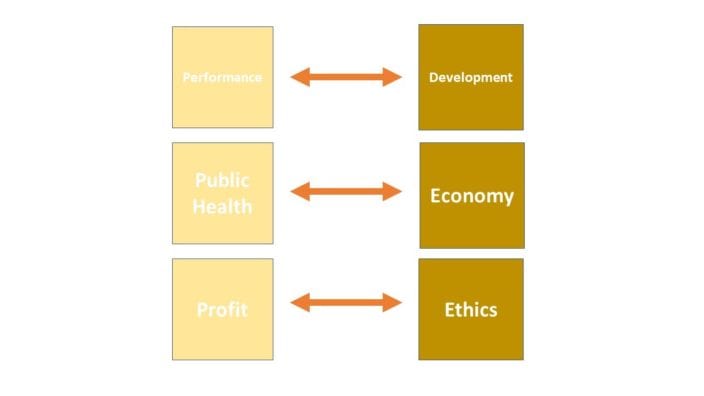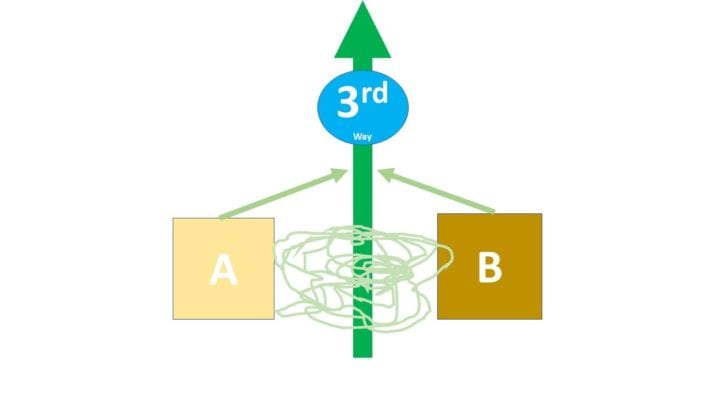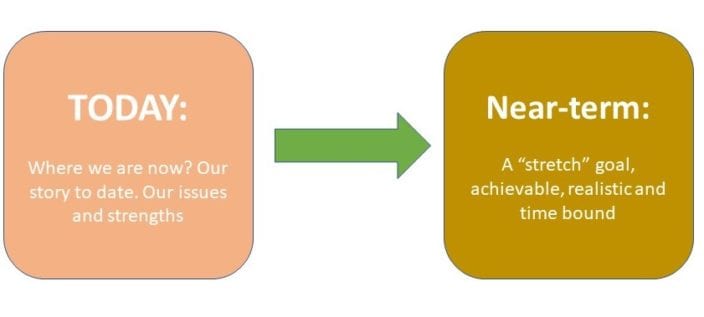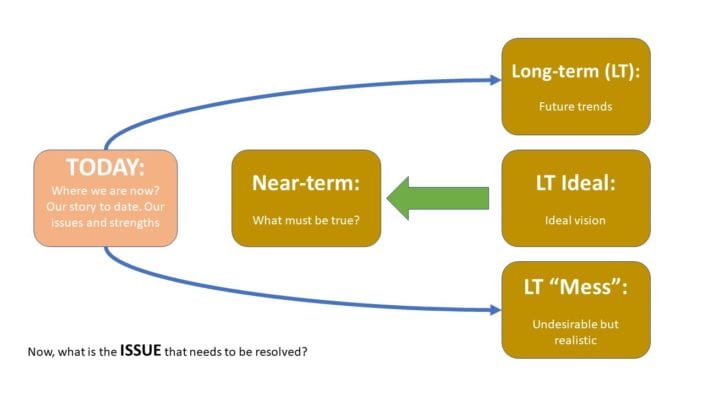It is time to explore the unharnessed potential of mediation.
Traditional mediation is sought by organisations when conflicts arise, and where the relevant parties have the wherewithal and willingness to engage in a voluntary process to find their own solution.
The mediator facilitates conversation, information is collated, and an acceptable solution is sought. Traditional mediation is effective for problems that are space and time bound and where the parties want to retain control over the process. This linear approach to problem-solving is reflected in the SISA model.
 Figure 1: SISA – mediation problem-solving model
Figure 1: SISA – mediation problem-solving model
The challenge for leaders is to distinguish between problems that have the potential to be solved through mediation and polarities that need to be mediated.
Problems versus Polarities
Polarities are interdependent pairs of opposites. Both sides of a polarity have ongoing importance and sustain each other over time (Beach et al, 2009). Polarities are also referred to as paradoxes, conflicting objectives, dilemmas or “sticky situations”. Some examples:
 Figure 2: Polarities to mediate
Figure 2: Polarities to mediate
Organisations are filled with polarities. Typically, they are characterised by a conflict between the present and the future. The short-term versus the long-term. The urgent versus the important.
Both perspectives matter. These are not either/or situations. However, as individuals we will tend to prefer one over the other.
Mediating between polarities is not as straightforward as solving problems using mediation. Polarity mediation requires an ongoing capability to synthesise conflicting perspectives, to navigate complexity, to accept ambiguity and to be agile. In contrast to problem solving, polarity mediation does not have an end point.
Where an organisation applies a problem-solving approach to a polarity that needs to be mediated, the consequences can be disastrous. Consider how Enron failed to mediate the polarity between profit and ethics.
Leaders who mistake polarities for problems will inevitably find themselves in regular tug-of-war positions pulled between win-lose propositions. The resulting dominance of either/or thinking puts their organisations in turmoil.
An example of a polarity that the world is familiar with right now is presented by the Covid 19 pandemic. By regarding it solely as a public health problem we may eradicate the virus. However, this would be to ignore the economic and wider societal cost of the consequent public health measures. Similarly, a sole focus on economic impact would risk a public health catastrophe. On inspection we can see that public health and the economy are over time an interdependent pair within the same system.
Mediation as a Development Function
I believe that the organisations who master the management of complexity will dominate their sectors. The leader’s job is to illuminate interdependency, integrate polarities and mediate a 3rd way.
 Figure 3: The leader’s role – mediating between polarities to uncover a 3rd way
Figure 3: The leader’s role – mediating between polarities to uncover a 3rd way
It is not the leader’s job to provide the answer. Rather their job is to guide the organisation on a discovery process by synthesising a “both/and” route forward that allows a 3rd way to emerge. Mediating between pairs of interdependent opposites is an organisational competence to nurture.
Where polarities are properly recognised and diverse perspectives are invited to mediate a 3rd way, (navigating paradox as opposed to suffering paradox), the role of the mediator changes from a remedial function to a development function, from curative to preventative. The leader moves from being a problem-solver to being a catalyst for change.
To take a computing analogy – rather than working with the participants to discover the information they need to make progress, development level mediators work on the operating system that the participants use to interpret information. Mediation as a service function is akin to adding a file to a computer. Mediation as a development function is akin to changing the operating system in the computer impacting how all files are interpreted.
What is the potential for moving mediation upwards on the value hierarchy by adopting a developmental focus?
Mediators as Leaders of Change and Transformation
Convening a gathering and mediating a way forward is the most human form of leadership.
Since the earliest human societies, leadership has involved the act of convening – bringing diverse individuals and groups together to mediate a common purpose. The job of the mediator involves skilfully convening others in a way that helps them to discover and mobilise their shared wisdom and energy. The mediator’s capacity to bring into the room a clear, calm, compassionate presence is essential to their effectiveness.
Mediators as leaders who do the challenging work of convening ‘difficult’ meetings are tapping into the transformational nature of conversations and relationships. Such mediators are motivated by the possibility that each conversation they convene might capture some small or large change in a world that is calling out for innovative, collaborative solutions.
Such is the power of conversation, and yet there is a lack of competence in organisations to have the conversations that matter. A common leadership mistake in organisations is to see their role as peacekeeper by supressing anything that is controversial, loud, emotional, or particularly polarising. But attempts to prevent or suppress uncertainty, conflict, and emotion inevitably produces a ‘fuel build-up’ – and the very thing that the organisation was trying to repress gets expressed – often in an uncontrolled and unpredictable way.
Organisations and communities have a build-up of voices not heard, issues not addressed and “undiscussables” that need desperately to be discussed. The leader as mediator releases the voices of concern, allows the expression of unpopular truths, enabling the full examination of the “elephant in the room”. Great mediators give everything a place, especially difficulty. Change flows when everything is seen. This is the 3rd way.
Mediation as a development function is not as a once-off last resort intervention. It is a way of being and a cultural competence.
Setting the framework for meaningful dialogue:
Part of the mediator’s job is to create the context for the meaningful conversations that enable the organisation to mediate a 3rd way with deliberative intent. The difficulty with most conversations in organisations is they are too narrow, too safe and predicated on the future being an extension of the past. As a result key issues are invariably missed (or avoided).
 Figure 4: Typical organisational conversation
Figure 4: Typical organisational conversation
An additional approach to organisational is to look back from the future thereby recognising strategy as a mediation between polarities rather than a problem to be solved. By integrating both perspectives a mediator sets the context for conversations with the transformative potential to enable a 3rd way.
 Figure 5: Alternative organisational conversation – (adapted from Krippendorff, K (2020))
Figure 5: Alternative organisational conversation – (adapted from Krippendorff, K (2020))
The mediator can create conversational space by invoking both a burning platform and a burning ambition, thereby bringing multiple polarities into view. The issue to be resolved becomes; if the long-term is true what do we need to do now? Participants are effectively painted into a corner which has the effect of releasing their creativity. This is where mediation meets strategy.
Margaret Wheatley (2017) asks these provocative questions.
“How many leaders spend time in the future? How many decisions are made using information from both present realities and future scenarios? How many organisations are willing to open their boundaries and absorb as much information as they can, knowing that it is only those exchanges that prevent deterioration and death.”
This is leader as mediator.
Mediators as models of the culture
Larry Dressler (2010) proposes that:
“the difference between competence and true mastery is the [mediator’s] way of being – an attitudinal, emotional, physical and even spiritual presence. It is a specific type of presence that others experience as fully engaged, open, authentic, relaxed, and grounded in purpose”.
Otto Scharmer (2018) argues in a similar vein that the impact of an intervention depends on the quality of the inner state of the intervenor. The nature of the mediator’s presence is as powerful an intervention as anything that they do or say. This is because participants absorb (consciously or unconsciously) what the mediator radiates.
Essentially, the mediator’s job is to bring their full, most conscious, and deliberate self to each interaction to serve as an instrument of positive change. This is a competence that goes beyond techniques, tactics, and the application of models. It is founded on the cultivation of a fully conscious awareness that is always curious, intentional, and acknowledging of the whole.
The master mediator in their role as leader sets the culture for the organisation, community or wherever they serve. The road to mastery never ends.
Reframing Mediation
I believe there is an opportunity to reframe mediation from a remedial intervention to one that is both creative and strategic. My hypothesis is that those organisations who master #mediatingthefuture are set to thrive.
Book your place at the pro bono conference Catalyzing the Future on 30th September 2020 to explore this and similar themes.
Return to home
Read about practicing agility

Share this on...